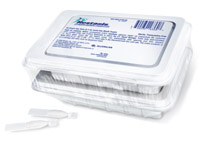 Q: I have a patient who takes Lipitor (atorvastatin calcium,
Pfizer) for hypercholesterolemia and was recently started on Restasis
(cyclosporine 0.05%, Allergan) b.i.d. for dry eye due to significant
conjunctival and corneal staining. A friend who is a pharmacist mentioned that
it might be contraindicated because of its potential to increase plasma
concentrations of the statin, and thus its possible side effects. Is there any
significance or viability to this claim?
Q: I have a patient who takes Lipitor (atorvastatin calcium,
Pfizer) for hypercholesterolemia and was recently started on Restasis
(cyclosporine 0.05%, Allergan) b.i.d. for dry eye due to significant
conjunctival and corneal staining. A friend who is a pharmacist mentioned that
it might be contraindicated because of its potential to increase plasma
concentrations of the statin, and thus its possible side effects. Is there any
significance or viability to this claim?
A: “While these drug interactions have been documented in patients taking the oral form of cyclosporine, the topical form, Restasis, has not shown this interaction,” says Ernie Bowling, O.D., of Gadsden, Ala.
Dr. Bowling points to one study that may have played a role in the development of this myth. “One case shows a patient who developed rhabdomyolysis following the use of cyclosporine for the treatment of chronic uveitis while also taking oral simvastatin for hypercholesterolemia, but the abstract does not state the form of cyclosporine used nor the concentration.”1
Statins, or lipid-lowering drugs, are “widely used in the prevention and treatment of atherosclerotic disease,” says Dr. Bowling. “The benefits of statins are well-documented, yet the drugs are not without risk.” Specifically, statins may cause myopathy and rhabdomyolysis, which can result in kidney damage.1
Cyclosporine inhibits the cytochromes, which metabolize statins. This, in turn, allows concentrations of statins in the plasma to build up, increasing the patient’s risk of adverse events.2
 But, for cyclosporine to have this effect, the patient needs
to be taking it in quantities greater than those resulting from topical ocular
instillation, says Dr. Bowling. “The concentration of cyclosporine in Restasis
is quite low—0.05%—and the medicine is diluted when applied to the eye. So, the
amount of drug found in the blood would be negligible.”
But, for cyclosporine to have this effect, the patient needs
to be taking it in quantities greater than those resulting from topical ocular
instillation, says Dr. Bowling. “The concentration of cyclosporine in Restasis
is quite low—0.05%—and the medicine is diluted when applied to the eye. So, the
amount of drug found in the blood would be negligible.”
The package insert for Restasis indicates: “Blood
concentrations of cyclosporine, in all the samples collected, after topical
administration of Restasis 0.05%, b.i.d., in humans for up to 12 months, were
below the quantitation limit of 0.1 ng/mL.
There was no detectable drug accumulation in blood during 12 months of treatment with Restasis ophthalmic emulsion.”3
If you believe that a particular case requires further research, discuss it with the patient’s generalist. “While we use the medication quite frequently in our patients with dry eye, it is prudent for patients with impaired liver or kidney function to be screened by their general physician before prescribing this medication,” suggests Dr. Bowling.
“Of course, anyone taking the oral form of cyclosporine should receive special attention,” Dr. Bowling says. “Kidney transplant patients are at a risk of hyperlipidemia and are managed with cyclosporine to reduce risk of rejection.4 In such cases, consult the patient’s nephrologist before beginning this medication.”
Bottom line: It’s extremely unlikely that the amount of
cyclosporine in a topical drug, such as Restasis, could cause an adverse reaction
with a statin drug. If you’re unsure, get the patient’s other health care
practitioners involved. “I’m a firm believer in consulting with my patient’s
generalist and specialists if I have any questions regarding the patient’s
medical history, medication use and my proposed therapeutic plans,” says Dr.
Bowling.
1. Lasocki A, Vote B, Fassett R, Zamir E. Simvastatin-induced rhabdomyolysis following cyclosporine treatment for uveitis. Ocular Immunol Inflamm. 2007 Jul-Aug;15(4):345-6.
2. Asberg A. Interactions between cyclosporin and lipid-lowering drugs: implications for organ transplant recipients. Drugs. 2003;63(4):367-78.
3. Allergan. Restasis package insert. January 2009.
4. Massy ZA. Hyperlipidemia and cardiovascular disease after organ transplantation. Transplantation. 2001 Sep 27;72(6 suppl):S13-5.

